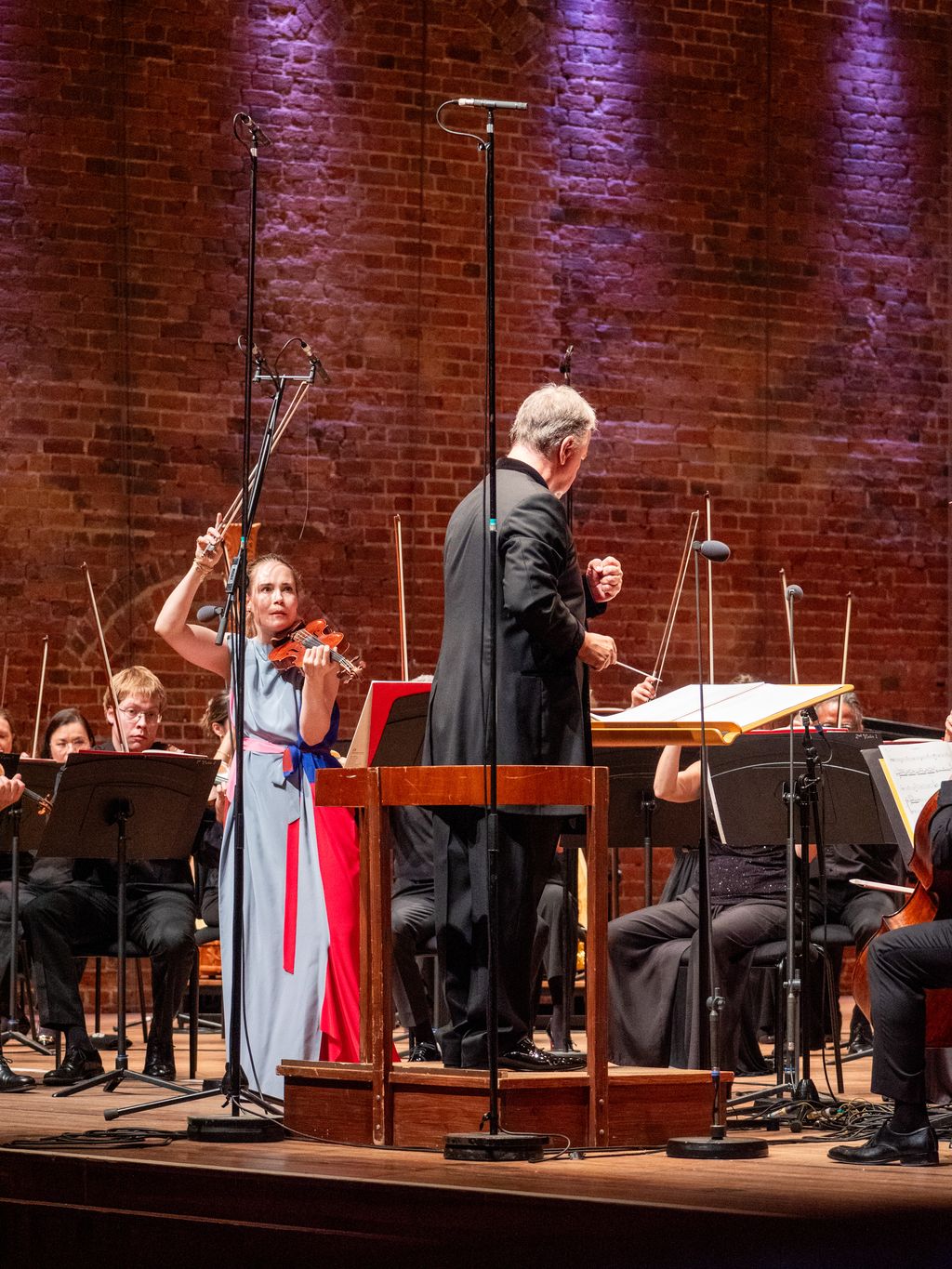Two standout evenings with the BBC Symphony Orchestra at the 2025 Aldeburgh Festival, featuring new works by Kidane, Grimes, and Elias alongside Strauss, Britten and Sibelius. Virtuosity, ambition, and moments of startling clarity across the weekend — with Leila Josefowicz and Allan Clayton especially compelling.
The first BBC Symphony Orchestra Aldeburgh concert opens with another chance to hear Daniel Kidane’s concert opener premiered at the Last Night of the Proms in 2019. Much has changed since that first outing, not least the title of the work – from Woke to Awake, a timely reflection of how the word itself has become a pejorative, or something that needs defending. There are clear if not distinct episodes in the 11 minute work, sparkling ricochets for all open the work, later shifting into a Reich-esque minimalist middle section. There’s a hint of menace in the final section that feels as though it might just grind to a halt. Heads craned to take in the sight of bullroarers spinning above the percussionists, before the orchestra coalesces around something big, warm and hopeful in one big glorious conclusion. Something for everyone in this crowd-pleasing concert opener.
In the standout work of the first evening, Leila Josefowicz seemed to size up Helen Grimes’ violin concerto score as though she was in the corner of the ring waiting for the big fight to begin. When she’s called upon to play, the energy in the writing is remarkable. Frenetic, powerful, and insistent: attention isn’t simply held because of the virtuosic acrobatics Grimes calls for from Josefowicz, but because the narrative line is, amongst all of the fireworks, utterly compelling. Grimes is a percussive writer, drawing not only percussion, but terrifying slap basses that sound industrial in feel and scope. The middle mysterious and murky section is all crystalline, upper register notes over suspended strings and depth charge chords from the brass and staples in the woodwind. Hers is colourful and vivid image painting, full of attack, and packed full of rhythmic interest and virtuosic demands. The shifts in contrast are extreme and gratifying, making the work feel longer than it is. Rarely has something quite so new landed quite so satisfyingly.

Strauss’ Four Last Songs concluded the first concert, with an unexpectedly disconcerting performance from soprano Anu Komsi. Hers is a piercing top line with a beautiful fluttering vibrato. At full pelt this is a remarkable feat and the intonation is secure too. But the dynamic range is extreme meaning that when the fortissimos are followed by a pianissimo in the vocal line, suddenly it feels as though the voice has completely fallen away. Either the orchestra was too loud in places (or Komsi needed to up the volume a bit), or she was singing for broadcast fully intending the microphones to capture the dynamic contrast. This combined with a lack of clarity in consonants meant that the verse was indistinct. A sense of disconnection pervaded.
In Britten’s first orchestral song cycle Our Hunting Fathers from 1936 Allan Clayton commands the stage with crystalline articulation demonstrating that even with surtitles, consonants not only matter but make all the difference to building connection. His solid delivery reflects the status the work has now acquired, demonstrating Britten’s mature compositional style, the twenty-two year old drawing on controversial but topical issues using the metaphor of hunting, particularly the relationship between humans and animals, to explore themes of violence, conformity, scapegoating, and dehumanisation. Anonymous texts and those penned by Auden, Ravenscroft provide Britten with an opportunity to lay out a selection of characteristically idiomatic writing, all of which will crop up in the many works he’ll be known and loved for in the years to come. Along with Clayton’s ever-reliable delivery and remarkably contained yet effective theatrics, the Snape acoustic made the inventiveness in Britten’s writing a fascinating exploration, even if the messaging is oblique. It is the details that make this an unsettling listen.
The programme notes for Elias’ new horn concerto give little away about the work, other than a light touch orientation, leaning instead into how a meeting with horn player Ben Goldscheider after a concert led to a lunch where a concerto was agreed upon. The programmes notes may well be sparse, but the notes on the page aren’t. The first movement is a fascinating study, though the ideas feel difficult to pin down and so the work difficult to follow. Goldscheider taps and bounces, marking beats and bars as he waits for his cue. In the lyrical slower middle section more evidence of Goldscheider’s firmer more confident lyrical tone, decorated with a pastoral counter-melody in the flute. Here, as in the Coleridge-Taylor Nonet earlier in the week there’s a real sense that his sound production has really shifted in the past 18 months. There are moments of breathtaking precision moving into the concerto’s concluding movement, with its fragmented material ricocheting across strings and wood, and the contrasting ominous string sounds, the material feels more cohesive, ideas settling down. This makes the first movement something in need of a re-listen: the concert is broadcast on Radio 3 on Tuesday 24th June.
In the concluding work of the BBC Symphony Orchestra’s two concert appearance at Aldeburgh, Sibelius 5 stirs and transcends in the stifling heat of Snape Maltings Concert Hall. Oramo and the assembled musicians have acclimatised themselves to the acoustics, navigating the fortissimos to great effect, honouring the epic range whilst maintaining the structural integrity of the building. There’s muscularity in the operatic declamations of the first movement with hyper-taut chase in the strings that culminates in a bright brassy conclusion. The second movement andante sees the orchestra at their finest, gently pulling, other times, heaving the long chorale from the earth beneath them. The final movement swans take flight, bringing a lump to the throat, the triumphant climactic hammer blows make full use of the ambience, providing a release that seems to reduce the temperature and usher in the East Suffolk coastal breeze.



